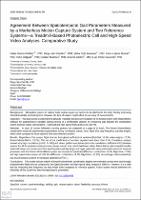Please use this identifier to cite or link to this item:
https://repositorio.usj.es/handle/123456789/444
| Title: | Agreement Between Spatiotemporal Gait Parameters Measured by a Markerless Motion Capture System and TwoReference Systems-a Treadmill-Based Photoelectric Cell and High-Speed Video Analyses: Comparative Study |
| Authors: | Roche-Seruendo, Luis Enrique



García-Pinillos, Felipe 


Cartón-Llorente, Antonio 
Jaén-Carrillo, Diego 


Soto-Hermoso, Víctor M. 


Latorre-Román, Pedro Á. 


Martínez, Cristian 

Delgado, Pedro 
|
| Keywords: | OptoGait; runners; sport technology; validity; gait; motion capture; video; feasibility; accuracy; Kinect |
| Issue Date: | 23-Oct-2020 |
| Citation: | García-Pinillos F, Jaén-Carrillo D, Soto Hermoso V, Latorre Román P, Delgado P, Martinez C, Carton A, Roche Seruendo L Agreement Between Spatiotemporal Gait Parameters Measured by a Markerless Motion Capture System and Two Reference Systems—a Treadmill-Based Photoelectric Cell and High-Speed Video Analyses: Comparative Study JMIR Mhealth Uhealth 2020;8(10):e19498 |
| Abstract: | Background: Markerless systems to capture body motion require no markers to be attached to the body, thereby improving clinical feasibility and testing time. However, the lack of markers might affect the accuracy of measurements. Objective: This study aimed to determine the absolute reliability and concurrent validity of the Kinect system with MotionMetrix software for spatiotemporal variables during running at a comfortable velocity, by comparing data between the combination system and two widely used systems—OptoGait and high-speed video analysis at 1000 Hz. Methods: In total, 25 runners followed a running protocol on a treadmill at a speed of 12 km/h. The Kinect+MotionMetrix combination measured spatiotemporal parameters during running (ie, contact time, flight time, step frequency, and step length), which were compared to those obtained from two reference systems. Results: Regardless of the system, flight time had the highest coefficients of variation (OptoGait: 16.4%; video analysis: 17.3%; Kinect+MotionMetrix: 23.2%). The rest of the coefficients of variation reported were lower than 8.1%. Correlation analysis showed very high correlations (r>0.8; P<.001) and almost perfect associations (intraclass correlation coefficient>0.81) between systems for all the spatiotemporal parameters except contact time, which had lower values. Bland-Altman plots revealed smaller systematic biases and random errors for step frequency and step length and larger systematic biases and random errors for temporal parameters with the Kinect+MotionMetrix system as compared to OptoGait (difference: contact time +3.0%, flight time −7.9%) and high-speed video analysis at 1000 Hz (difference: contact time +4.2%, flight time −11.3%). Accordingly, heteroscedasticity was found between systems for temporal parameters (r 2>0.1). Conclusions: The results indicate that the Kinect+MotionMetrix combination slightly overestimates contact time and strongly underestimates flight time as compared to the OptoGait system and high-speed video analysis at 1000 Hz. However, it is a valid tool for measuring step frequency and step length when compared to reference systems. Future studies should determine the reliability of this system for determining temporal parameters. |
| URI: | https://repositorio.usj.es/handle/123456789/444 |
| ISSN: | 2291-5222 |
| Appears in Collections: | Artículos de revistas |
Files in This Item:
| File | Description | Size | Format | |
|---|---|---|---|---|
| Agreement Between Spatiotemporal Gait Parameters Measured.pdf | 551,38 kB | Adobe PDF |  View/Open |
This item is licensed under a Creative Commons License

